If you don’t know much about guitar playing, it can seem like there is never really a point where you have to change guitar strings. In fact, over the years, I’ve noticed casual players will typically never change their strings.
This all changes when guitarists start worrying more about tone. Once they actually care, they start wondering when their strings actually die out which ultimately depends on a few factors that we’ll explore a bit later.
Most guitarists will notice their strings becoming noticeably stale and dirty after 80 to 120 hours of playing. For guitarists who play frequently for up to + 4 hours a day, this can be 2-3 weeks or even 1-2 weeks. Conversely, guitarists who rarely play might not notice a dull tone until 2-3 months.
A serious player who uses the instrument every day might have to change the set every couple of weeks, while another one may change it every 3 months. A lot of this has to do with how much oil your hands produce, the climate in which the guitar sits, and perhaps more importantly, whether the guitarist is a touring musician or not.
How to Tell If Your Guitar Strings Are Dead?
1) Do the Fingernail Scrape Test
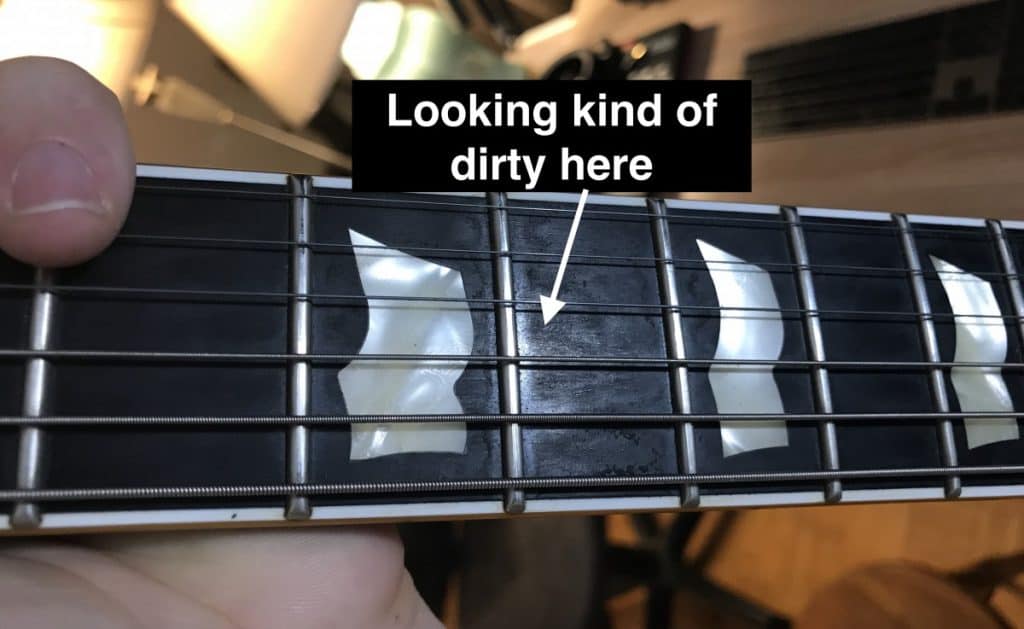
There are a few different ways to tell if your guitar strings are dead, however, I find the best way, right off the bat, is to just drag your fingernail on the underside of the high e-string.
If there is a lot of dirt, grime, or gunk on your fingernail after you’ve done the “scrape test,” then this is a good sign that it’s time to change your strings. There’s no question that this is the best way of determining whether it’s time to change your strings or not.
You can do this in a couple of ways as well, for instance, you could scrape the dull end of a butter knife along the bottom of the string to see if any particles of dirt and grime fall off the string. It’s the same effect, albeit, a little less gross.
Assuming you used your fingernail to do it the first time, you’ll have to wash your hands right after, which brings me to my next point.
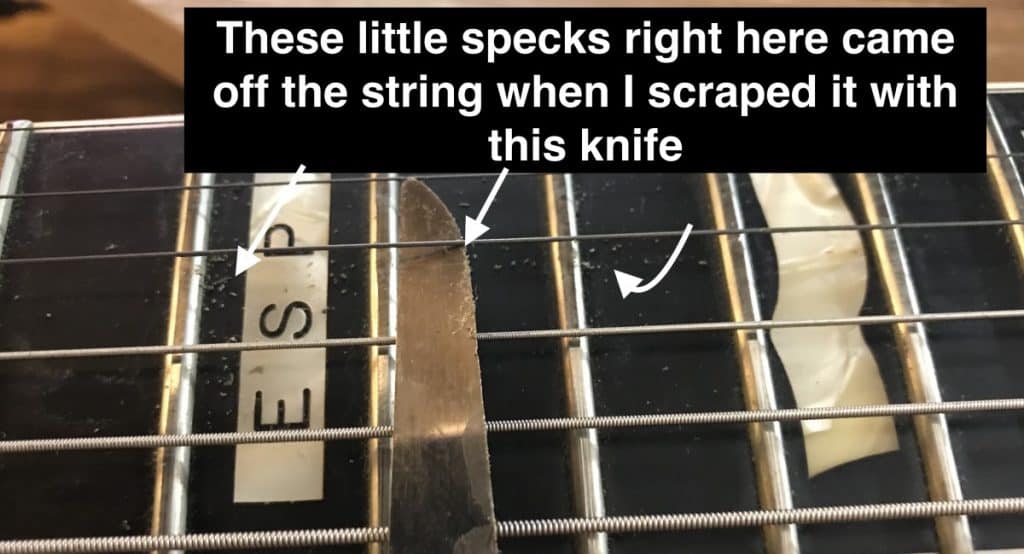
2) You Have to Wash Your Hands After Playing

If you have to wash your hands after you’re done playing guitar, this is another sign that it’s time to change your guitar strings.
As I type this, I’m thinking about some of the guitars that I haven’t touched in a while, including my beloved ESP Eclipse II, which has a thick layer of dust and grime all over it. There’s just something about a dirty guitar that is incredibly disconcerting.
A filthy guitar also has a particular feel and look to it. After playing for some time and getting a better idea of what the instrument is supposed to feel, look, and sound like, it becomes a lot more obvious that the guitar is extremely dirty.
For instance, I would describe the guitar as having a “sludgy,” “slow,” or “grimy” feel to it after picking it up. The strings look kind of black and it just doesn’t feel good to play it.
Admittedly, you’ll need a clean or a new guitar to compare and contrast to really get an idea of the difference between the two, however, if you’re a beginner guitarist and you only have one guitar, it’s hard to judge just how clean or dirty the instrument is, because you may have no frame of reference.
Another big way that I tell that I need new strings is how they sound, particularly on the higher E and B strings.
3) It Doesn’t Sound as Good Anymore
This is a big one, but yet another example of the importance of having a good frame of reference. If you don’t have another guitar to compare and contrast, you won’t have as good of an idea of just how bad the strings are. But I digress.
I find this point is more important for acoustic guitar strings than it is for electric guitar strings. Of course, your electric guitar strings won’t sound as good anymore either after they’ve worn out a bit, but from what I’ve seen and heard with my own eyes and ears, an acoustic guitar will be WAY more obvious when it’s time to change the strings.
This makes sense because an acoustic guitar is far more raw. What do I mean by that? There are no pickups, electronics, amplifiers, effects, distortion pedals, or cabinets to mask how bad the strings sound.
If the strings are bad on an acoustic guitar, it’s going to reverberate from the wood and the soundhole and be very obvious to anyone who knows and is familiar with how a guitar should sound.
For example, if you take a look at the YouTube video at the bottom of this section, pay careful attention to the brightness and tone of the way the acoustic guitar sounds. It’s difficult to pick up on through a YouTube video.
But there is a clear difference between the way the guitar sounds with new strings versus old strings. It doesn’t matter if you have an excellent acoustic like the Martin GPC-16E; if the strings are bad, it’s going to sound bad.
4) The Entire Guitar, Especially the Fretboard, is Dusty and Dirty
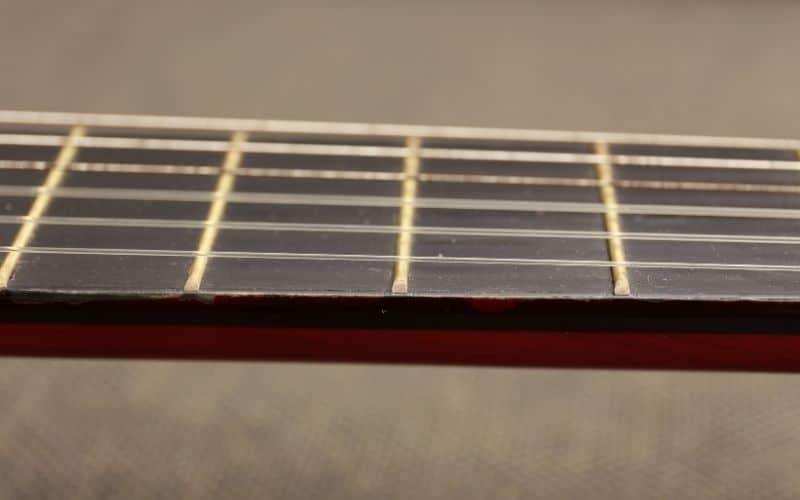
As I already briefly mentioned in passing, my ESP Eclipse II right now is sitting in the corner and I can see the dust collecting on it from here. These days, I opt for my PRS SE Custom 24 simply because I don’t play metal much anymore.
In any case, it’s quite obvious that the ESP needs a string change even from looking at it from a distance. Chances are if your guitar fretboard, neck, and body are dirty, you probably need a fresh pair of strings as well.
In the image below, you can see the grime and build-up on not only the strings themselves but the frets too.
Take a moment to clean your guitar using Ernie Ball’s microfibre cloth and tool-kit, I find it’s worth the time and energy to wipe it down every once in a while.
Obviously, the best time to do this is in between string changes which I tend to do quite frequently due to the reason that I’m about to mention here: the way the guitar sounds between the 12th and 17th fret after they’ve worn down.
5) The High E-String Sounds Weird at the 12th to 17th Fret
This is one that I’ve never heard anyone else talk about, so I think it might just be me who has noticed. But I find that it’s actually the high E-string that always goes first, and it’s usually up in the higher register, like between the 12th and 17th fret, for instance.
If you listen to the audio recording below, you can kind of hear the way it sounds. Notice that gross reverberation? Yeah, it sounds nasty and I’m not a fan of it.

It’s not ringing out clean and consistently, it’s kind of “warbling,” to put it in a less eloquent way. For me, this is probably the earliest sign that it’s time to replace my guitar strings and it usually starts to happen to the high e-string after 3-4 weeks.
After a full month, the warble is in full force again, and then I have to change them because of it unless you use a brand like Elixir from Amazon which tends to last much longer.
One thing that I noticed while making this video is that there is considerably more sustain on the new E-string as well.
6) The Strings Have Discoloured Spots On Them
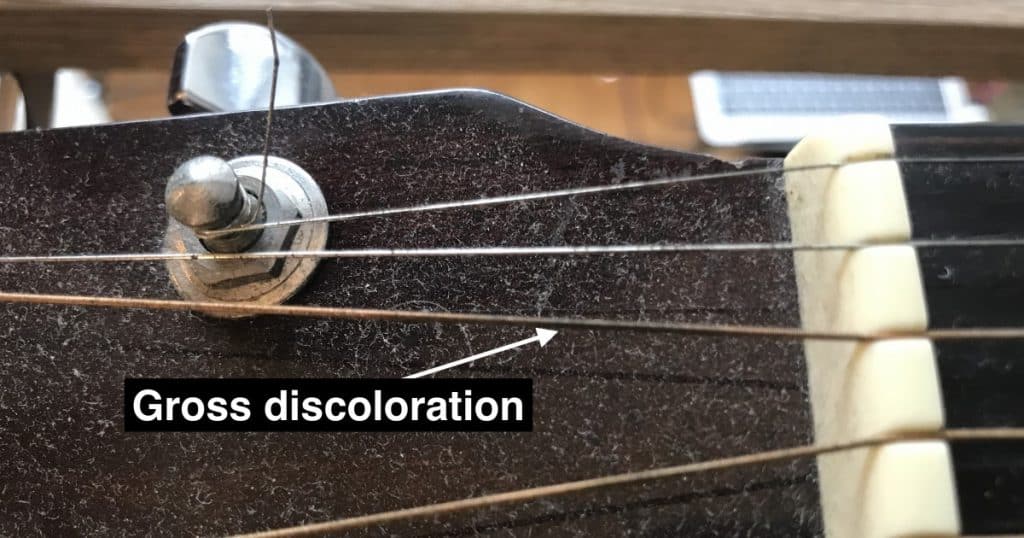
This is self-explanatory but equally valid. I find guitar strings, after a few months, will start to look bad and not just sound bad. They get this weird discoloured look at certain parts of the string.
This isn’t the best way of gauging whether it’s time to change your strings or not, but it’s still a sign, regardless. By “discoloration,” I’m referring less to the wood on the body, itself, and more to the strings.
Strings that are very old tend to get a brown or darkened spot on them that doesn’t look good. You can clearly see it in the image shown above. Notice how there is a darkened spot on the phosphor bronze strings?
Yeah, that’s what I’m talking about, and it doesn’t look or, more importantly, sound good. Regarding when is the best time to change your strings? I think there are a few best practices that I can help you with.
When to Change Your Guitar Strings? The Best Chart
So after you’ve determined that it’s time to get some new guitar strings on your instrument and you’ve done so either by yourself or via a professional, you may find yourself wondering how often this should be done, and most people will say the exact same thing: it depends.
It depends on how often you play, how sweaty you are, etc. And this is all true because it does really depend on these factors.
However, I’ve come up with a chart that’s based on my own personal experience and that of a few others, and we agreed that this was a useful way of informing a beginner how often they should change their strings.
Based on perusing this thread from Reddit, as well, I find this chart below is a useful guideline for how often you should change your strings.
| How Often You Play | When to Change Strings |
| Every Day | 5-8 Weeks |
| Every Other Day | After 2 Months |
| Once per Week | Every 6 months |
| Once per Month | Once Per Year |
| Once Every 6 Months | *Put on coated strings like Elixirs and then don’t bother changing them for several years. |
| I Never Play | *Same as above. |
Important Things to Mention About Worn-Out Guitar Strings
1) Change Your Strings Once Every 2 Months If You Care About Tone
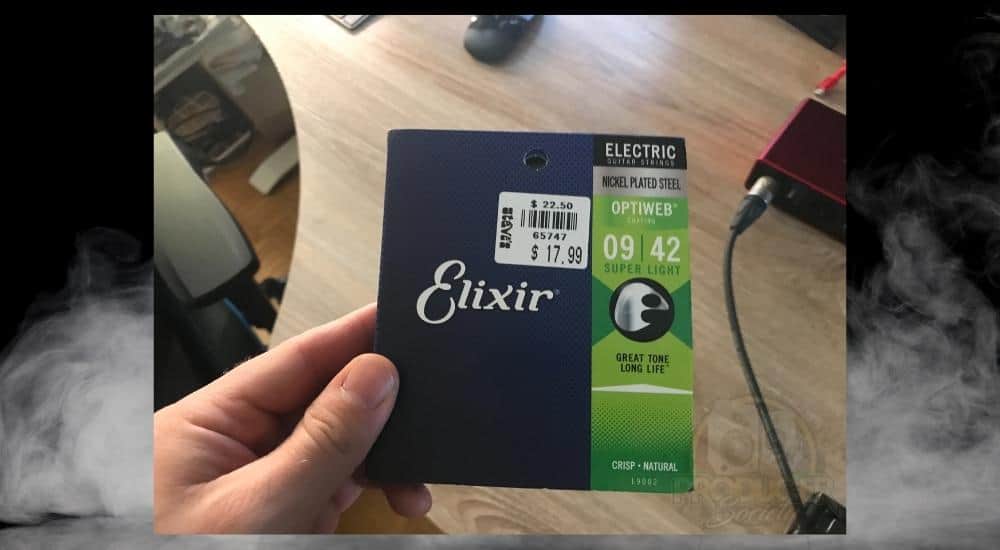
How much you wear out your instrument depends a lot on a few factors, notably, how often you sweat and the level of acidity in the sweat.
I’ve heard stories from other players who say that they’ve lent their guitar to another player for just a few minutes and when they get their guitar back, it’s almost like the instrument’s strings have been dulled already.
While this is probably an exaggeration, there is something to be said about how sweaty other humans are, and there’s no doubt that this oil, especially after it has dried on the strings, will impact their longevity.
This is one of the reasons why my guitar teacher always used to tell me that wiping strings down with a towel after was a great way of making them last longer.
2) If You Don’t Care About Tone – Don’t Even Bother

Not everyone even cares that much about how the guitar sounds. For instance, an old friend of mine would have the same pair of strings on them forever if I didn’t change them for him every once in a while.
He simply didn’t care, and that’s cool too. There’s something kind of cool and punk rock about not changing your strings, to be honest, and there are some people out there who don’t bother.
However, that’s also because he was more into punk rather than metal, instrumental music, and music-production-heavy music like me. In other words, if you don’t want to change your strings, you don’t have to at all.
For some people, they’ll keep the same pair of strings on their instrument for years. Legend has it that Ben Shepherd from Soundgarden never changed his strings ever, and actually preferred the way they sounded.
Other Articles You May Be Interested In
- Should Guitar Strings Be The Same Height? [NO]
- How Tight Should Guitar Strings Be? [ANSWERED]
- What’s the Difference Between Light & Medium Guitar Strings?


 Written By :
Written By :
